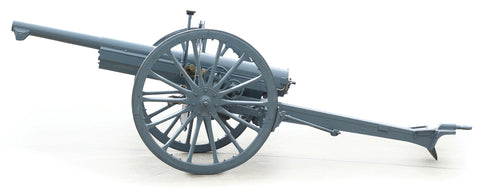
How The ‘French 75’ Started A Revolution in Field Artillery
The Matériel de 75mm Mle 1897 —aka the “French 75” or Soixante-Quinze —was a revolution in field artillery. In 1890, Gen. Charles Mathieu, Director of Artillery at the French Ministry of War, commissioned Lt. Col. Joseph-Albert Deport, director of the Atelier de Construction de Puteaux (APX) state arsenal, to develop a new French artillery recoil system in response to intelligence about similar German efforts.
The result was the 75mm Mle 1897, officially adopted for French Army service in 1898. It utilized a hydro-pneumatic recoil system that allowed the barrel to recoil fully then return to its original position while the carriage stayed perfectly still.
This mechanism, combined with a fast-action screw breech and unitary shell, enabled a well-trained crew to fire 15–30 shrapnel or high-explosive shells every minute—previous guns fired about two shells per minute. It required no repositioning and resighting after every shot, a key problem with contemporary field artillery.
The defining French field artillery piece of World War I, it fired more than 16 million shells at the 1916 Battle of Verdun alone. The gun was such a compelling package that it was adopted and manufactured in large numbers by the U.S. Army—the first American shell fired in World War I came on Oct. 23, 1917 from a 75 mm Gun M1897 (the U.S. designation) nicknamed “Bridget” in Battery C, 6th Field Artillery.
Many other countries, including Britain, Romania, Poland and Germany, adopted the gun in the interwar period and also in early World War II, in various mounts and adaptations (including the US M3 Gun Motor Carriage, an early tank destroyer). By the time it started to show its obsolescence in the early 1940s, it had already transformed the design of field artillery.
French
75mm M1897 Field Gun
Barrel
The 8ft 10 in barrel could deliver fire to an effective range of 9,300 yards for high-explosive and 7,400 yards for shrapnel. The gun could also fire gas shells.
Elevation and traverse
The barrel had a fairly shallow elevation range (−11° to +18°), reflecting the gun’s direct-fire trajectory. The gun could be traversed 3° to either side on the threaded wheel axle.
Recoil mechanism
It squeezed oil from an upper to lower cylinder containing oil and compressed air separated by a piston. Air slowed the recoil and equalized pressure returned the gun to firing position.
Breech
The breech was a Nordenfelt rotating eccentric-screw type, which allowed fast opening and closing by rotating the breech handle through just a quarter turn.
Trail
The original M1897 had a box trail carriage, replaced in the interwar period by a more flexible split-trail carriage.
